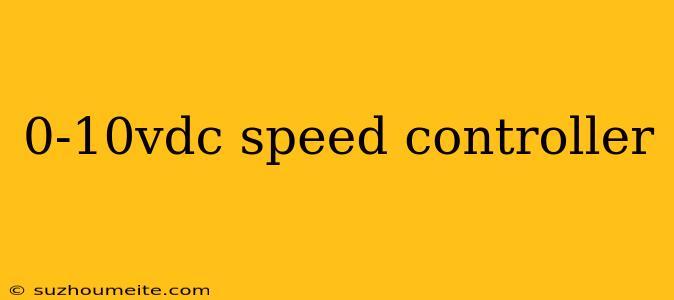0-10VDC Speed Controller: A Comprehensive Guide
What is a 0-10VDC Speed Controller?
A 0-10VDC speed controller is a type of device that regulates the speed of a motor or other electrical load by varying the voltage supplied to it. This type of controller is commonly used in industrial automation, robotics, and HVAC (heating, ventilation, and air conditioning) systems.
How Does a 0-10VDC Speed Controller Work?
A 0-10VDC speed controller works by receiving a control signal from a external device, such as a potentiometer, temperature sensor, or PLC (programmable logic controller). This control signal is typically a 0-10VDC analog signal that corresponds to the desired speed of the motor.
The speed controller then adjusts the output voltage to the motor accordingly, allowing the motor to operate at the desired speed. The output voltage can be adjusted in real-time, allowing for precise control over the motor's speed.
Key Features of a 0-10VDC Speed Controller
- Analog input: accepts a 0-10VDC analog signal from an external device
- Variable speed control: allows for precise control over the motor's speed
- Adjustable output voltage: output voltage can be adjusted in real-time to achieve the desired speed
- Overcurrent protection: protects the motor and controller from overcurrent conditions
- Short-circuit protection: protects the motor and controller from short-circuit conditions
Applications of a 0-10VDC Speed Controller
0-10VDC speed controllers are commonly used in a variety of applications, including:
- HVAC systems: to control fan speed, pump speed, and compressor speed
- Industrial automation: to control motor speed in conveying systems, pumps, and blowers
- Robotics: to control motor speed in robotic arms, grippers, and other mechanisms
- Medical equipment: to control motor speed in medical devices, such as ventilators and dialysis machines
Benefits of a 0-10VDC Speed Controller
- Energy efficiency: allows for precise control over motor speed, reducing energy consumption
- Increased precision: allows for precise control over motor speed, reducing errors and improving performance
- Flexibility: can be used in a variety of applications, including HVAC, industrial automation, robotics, and medical equipment
- Cost-effective: can be more cost-effective than other types of speed controllers, such as PWM (pulse-width modulation) controllers
Conclusion
In conclusion, a 0-10VDC speed controller is a versatile and precise device that allows for accurate control over motor speed. With its analog input, variable speed control, and adjustable output voltage, it is suitable for a wide range of applications. Its benefits, including energy efficiency, increased precision, flexibility, and cost-effectiveness, make it a popular choice in many industries.
